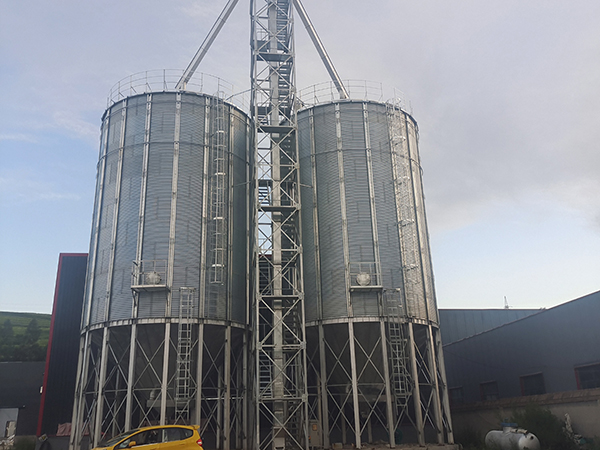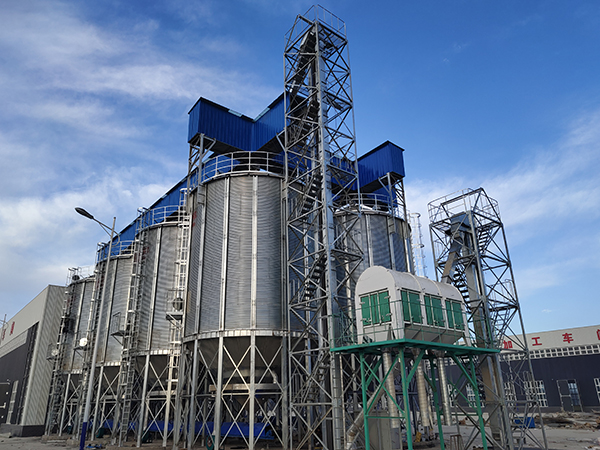Poultry feed silo
poultry feed silo is a facility used for storing and managing poultry feed. It typically consists of a cylindrical structure with a certain capacity
Poultry feed silo Introduction
A poultry feed silo is a facility used for storing and managing poultry feed. It typically consists of a cylindrical structure with a certain capacity, designed to store feed for poultry such as chickens, ducks, and geese to meet the needs of poultry farming. The design of poultry feed silos aims to keep the feed fresh and dry, preventing it from becoming damp, moldy, or contaminated. These silos often feature good sealing and ventilation systems to ensure the quality and nutritional value of the feed. Poultry feed silos find application in various poultry farming settings, including poultry farms, chicken farms, and goose farms, serving as crucial facilities for providing high-quality feed to poultry.


Characteristics of poultry feed silo
Large Capacity Storage
Feed silos typically offer substantial interior space capable of holding vast quantities of poultry feed, catering to the needs of large-scale farms, reducing frequent procurement and transportation costs, and enhancing feed management efficiency.
Exceptional Sealability
The silo structure emphasizes tight sealing, with walls, roof, and doors made from impermeable materials or employing sealing techniques, preventing ingress of rainwater, moisture, pests, and external contaminants, ensuring feed remains dry, clean, and free from mold, oxidation, and infestation during storage.
Automated Feeding System
At the silo bottom, automated feed conveying equipment, such as screw conveyors or augers, is commonly installed. These devices can deliver feed to various rearing areas in the farm according to pre-set schedules and quantities, enabling precise feeding, labor savings, and ensuring even feed intake among poultry.
Ventilation & Insulation Design
Poultry feed silos may incorporate ventilation openings, fans, or other devices to regulate air circulation within the silo, preventing high temperatures that could degrade feed quality. Additionally, the outer walls may be insulated to minimize the impact of external temperature fluctuations on stored feed, maintaining optimal storage conditions.
Anti-Caking & Explosion Prevention
Given the tendency of feed to form caking, silos may incorporate anti-caking devices like de-bonding machines or vibrators to eliminate voids that form during feed accumulation, ensuring smooth flow. Furthermore, considering the risk of feed dust explosions, silos may be equipped with explosion prevention devices or designed in accordance with explosion protection standards, ensuring safe operation.
Intelligent Monitoring & Management
Contemporary feed silos often feature temperature and humidity monitoring, feed inventory monitoring, and dust concentration monitoring, all integrated into a remote control system. This setup enables real-time supervision of the silo’s internal environment, allowing for prompt adjustments to ventilation, moisture control measures, ensuring feed quality, and guiding feed purchases and allocation based on stock levels.
Ease of Cleaning & Maintenance
The internal structure of the silo is designed for easy cleaning, conforming to the rigorous hygiene standards of the poultry industry. Smooth walls without niches, sloping bottoms, or dedicated cleaning mechanisms facilitate the complete removal of residual feed, preventing mold growth.
Structural Strength & Durability
Constructed using high-strength materials, poultry feed silos boast sturdy structures capable of withstanding the weight of stored feed and harsh weather conditions (such as wind, snow, and earthquakes), ensuring long-term, reliable service.


Poultry feed silo structure
The main body of the silo
The main body of the silo, typically cylindrical in shape, serves as the primary structure for storing poultry feed. It is usually constructed from materials such as metal or concrete, providing durability and load-bearing capacity.
Inlet port
The inlet port is located at the top or side of the silo and is used to transfer feed into the interior of the silo. It facilitates the easy loading of feed into the silo.
Outlet port
The outlet port is located at the bottom or side of the silo and is used to remove stored feed from the silo. It allows for easy retrieval of feed.
Sealing system
Poultry feed silos are equipped with a sealing system, such as sealed doors or covers, to prevent feed from becoming damp, infested with pests, or contaminated by other substances.
Ventilation system
Some silos may be fitted with a ventilation system to maintain airflow within the silo, preventing feed from becoming damp or moldy and preserving feed quality.
Supporting structure
To support the weight of the silo and ensure its stability, supporting structures such as pillars or brackets are typically installed around the silo.
Conveying system
Some large poultry feed silos may be equipped with a conveying system to transport feed from the storage area to the outlet port, enabling more efficient retrieval of feed.


Advantages of poultry feed silo
Maintaining feed quality
The silo design facilitates maintaining the freshness and quality of feed by effectively sealing and ventilating the system, preventing it from becoming damp, moldy, or contaminated, ensuring the nutritional value and safety of the feed.
Convenient management
Poultry feed silos are easy to manage and operate, allowing caregivers to easily store, access, and manage feed, thereby improving work efficiency.
Space-saving
Silos are typically vertical structures, enabling the storage of large quantities of feed in limited space, saving space and increasing space utilization.
Supply assurance
Poultry feed silos can store large quantities of feed, ensuring a stable supply of feed, avoiding disruptions in poultry growth and production due to feed shortages.
Reduced wastage
Through effective sealing and management, poultry feed silos can reduce feed wastage and losses, improve feed utilization, and save on farming costs.
Pollution prevention
The silo’s sealing system effectively prevents feed from being contaminated by external environmental factors, maintaining feed hygiene and safety, and reducing health issues caused by feed contamination.
Strong customization
Depending on the farming site and specific requirements, poultry feed silos can be customized in different sizes and designs to meet specific farming needs and demands.

Poultry Feed Silo Applications
Large-scale Breeding Farms
In large-scale poultry breeding farms such as chicken farms, duck farms, goose farms, and turkey farms, feed silos are essential infrastructure. The silos are used to centrally store various types of poultry feed (such as pellets, powder, premix, etc.), facilitating precise distribution to various feeding areas as needed, achieving accurate feeding and improving breeding efficiency.
Feed Processing Enterprises
Feed processing plants typically establish large feed silos for temporary storage of self-produced or externally purchased feed ingredients (such as corn, soybean meal, fish meal, etc.) or finished feed. The silos not only facilitate material turnover and ingredient mixing but also ensure feed quality, reducing losses caused by improper storage.
Feed Distribution Centers
Feed distribution centers established by logistics companies or feed trading companies use feed silos to centrally store and sort various types of poultry feed. They quickly load and dispatch orders based on customer requirements, serving surrounding small and medium-sized breeding farms or retail markets.
Breeding Stock Breeding Bases
In breeding stock breeding bases (such as breeding chicken, duck, and goose farms), feed silos are used to store high-quality, precisely-nutritious feed for breeding stock, ensuring their healthy growth and reproductive performance.
Poultry Feed Silo technical parameters
Scientifically speaking, the Silo capacity should be measured with volume (m3). Even in the same grain Silo, the storage tons will be different for different grains with different densities. The following table is calculated based on a Silo density of 0.75kg/m3, and surely HKB customizes Silo systems unique for you.
| Most Popular Hopper Bottom Steel Silo Technical Specifications | ||||||||
| Capacity | 50Ton | 100Ton | 150Ton | 200Ton | 300Ton | 500Ton | 1000Ton | 1500Ton |
| Model | TCZK
03605 |
TCZK
04507 |
TCZK
05507 |
TCZK
06406 |
TCZK
07307 |
TCZK
07313 |
TCZK
11010 |
TCZK
12811 |
| Diameter(m) | 3.667 | 4.584 | 5.500 | 6.417 | 7.334 | 7.334 | 11.000 | 12.834 |
| Total Height(m) | 9.56 | 12.53 | 13.25 | 12.85 | 14.70 | 21.42 | 20.95 | 23.51 |
| Volume(m³)
Density:0.75ton/m³ |
69 | 150 | 222 | 273 | 415 | 699 | 1346 | 2039 |
| Most Popular Flat Bottom Steel Silo Technical Specifications | ||||||||
| Capacity | 1000Ton | 1500Ton | 2000Ton | 2500Ton | 3000Ton | 5000Ton | 8000Ton | 10000Ton |
| Model | TCK
10014 |
TCK
11915 |
TCK
13715 |
TCK
15514 |
TCK
15518 |
TCK
18321 |
TCK
24718 |
TCK
25621 |
| Diameter(m) | 10.084 | 11.918 | 13.750 | 15.584 | 15.584 | 18.334 | 24.751 | 25.668 |
| Total Height(m) | 18.69 | 20.34 | 20.87 | 20.30 | 24.78 | 28.60 | 26.99 | 30.60 |
| Volume(m³)
Density: 0.75ton/m³ |
1335 | 2009 | 2701 | 2467 | 4145 | 6693 | 10879 | 13484 |








